

This ring handle first appears in the Newman Brothers’ catalogue circa 1920, under ‘Cast Brass Ring Handles’. However, this is not brass, but a brown-bronzed zinc handle. It is die cast, a process that Newman Brothers began using in the 1950s.
Die casting is a method of metal casting that uses one solid die mould to repeatedly create many instances of the same item. This die mould consists of two sections that when put together have a hollow centre which gives the item being cast its shape. Molten metal is injected under pressure to fill this hollow area and the whole thing is allowed to cool. When cool the two halves of the die mould are separated to reveal a the solid metal item inside which can then be taken out to allow the die mould to be used again to make another, virtually identical, item.
Newman Brothers were known for their variety of finishes, including their bronze lacquers. The Brown Bronze finish that we see here was achieved by mixing rouge with a small amount of chloride of platinum and water, this created a chocolate brown solution that was mixed with water to form a paste. Bronze finishes were applied to an object with a soft brush and allowed to dry. A harder brush was then applied to the object until the finish had become appropriately brightened.
We know from an article published in the Funeral Service Journal in 1950 that it was “the company’s aim in the future to be entirely self-contained and to this end a new die-casting and die-making facility is being catered for.” By the late 1950s, Newman Brothers had ceased sand casting at the manufactory. This die cast ornament was produced off site, most probably at GEO. Gale (Die Casters) LTD, who manufactured most of their die cast products.







